
1118 WIRELESS REMOTE
INDICATOR LIGHT
Installation Guide
Figure 1: 1118 Wireless Remote
Indicator Light
The 1118 Wireless Remote Indicator Light
provides one remote LED indicator that
can be used to visually notify the user
that a panic alarm has been activated.
The 1118 is designed to operate with
one CR123A battery or optional
12VDCpower supply.
Compatibility
• XR150/XR550 Series panels
• 1100X Series wireless receivers with
Version 104 or higher.
What is Included?
• 1118 Wireless Remote Indicator Light
• 3V Lithium CR123A battery
• Hardware pack
1
PROGRAM THE PANEL
Program the 1118 as a panic alarm output. Refer to the
panel programming guide as needed.
1. In OUTPUT INFO, enter the OUTPUT number.
2. Enter the OUTPUT NAME.
3. Enter the eight-digit SERIAL# and press CMD.
4. Enter the SUPRVSN TIME and press CMD.
5. Press the back arrow when OUTPUT INFO
displays.
6. Press the back arrow to OUTPUT OPTIONS and
select CMD.
7. Navigate to PANIC ALM OUT and select a top
row key or area.
8. Enter the output number for the 1118. Select
CMD.
9. Press CMD until STOP displays and then press
any select area to save and exit programming.
Program Slow Response
Use wireless output numbers 450-474 to indicate
whether the wireless device responds within 15
seconds to trip the output (slow response).
Program Fast Response
Use wireless output numbers 480-499 to indicate
whether the wireless device responds within 1 second
to trip the output (fast response).
Note: For wireless output troubles to display
at a keypad, specify the keypad address at the
AUX1ZONES option in the Status List menu.
DESCRIPTION
2
POWER THE 1118
Power the device with a 3V lithium battery or a
12VDC power supply, such as a DMP Model 376L
or DMP Model 505-12. Do not install a battery if the
device is being powered by a power supply. The
power supply does not charge the battery.
CR123A 3.0 V Lithium Battery
The device can be powered with a 3.0V lithium
battery.
1. Remove the housing cover.
2. Install the supplied jumper on the two pins next
to BAT on the power source header.
3. Place the battery in the holder and observe
polarity.
4. Snap the cover back into place.

2 1118 INSTALLATION GUIDE | DIGITAL MONITORING PRODUCTS
12 VDC Plug-In or External Power
Supply
The device can also be powered by a 12VDC
plug-in power supply (DMPModel 376L) or a
12VDC external power supply (DMP Model 505-
12). When using a plug-in power supply, mount
the device near a wall outlet.
1. Remove the housing cover.
2. Install the supplied jumper on the two
pins next to EXT on the power source
header.
3. Wire the power supply to the DC power
terminals by following the power supply-specific
instructions below.
Plug-In Power Supply
Connect the black wire with the white stripe to the
positive (+) terminal and the solid black wire to the
negative (-) terminal. See Figure 2. Plug the power
supply into an unswitched 110VAC outlet.
External Power Supply
Use 22AWG wire to connect the DC power
terminal block on the device to the DC power
terminal on the 505-12 power supply PCB. Connect
the transformer to an unswitched 120VAC 1.5 Amp
power source. See Figure3 for wiring.
4. Snap the cover back into place.
The device provides a Survey LED capability to allow one person to confirm communication with
the wireless receiver or panel while the cover is removed.
1. With the cover removed, hold the device in the desired location.
2. Press the tamper switch to determine if communication is confirmed or faulty.
Confirmed: If communication is confirmed, for each press or release of the tamper switch,
the LED blinks immediately on and immediately off.
Faulty: If communication is faulty, the LED remains on for about 8 seconds or flashes
multiple times in quick succession. Relocate the device or receiver until the LED confirms
clear communication.
Figure 2: Wireless Expander Side View
Figure 3: Power Supply Connection
+ DC -
505-12 Power
Supply
12 VDC
22 AWG
Wire
DC Power
2-position
Terminal Block
- +
- +
DC
Plug-in
Power
Supply
DC Power
2-position
Terminal Block
- +
- +
Black Wire
with White
Stripe
to Positive
Black Wire
to
Negative
3
SELECT A LOCATION

1118 INSTALLATION GUIDE | DIGITAL MONITORING PRODUCTS 3
Mount the device on a flat surface such as a wall or single-gang box. If using the optional Model
376L plug-in power supply, mount the device near a wall outlet. See Figure 4 for mounting hole
locations on the housing base.
4
MOUNT THE 1118
Figure 4: Mounting Hole Locations
Mounting Holes
TESTING THE 1118
To test the device from a keypad, access the User Menu Outputs On/Off option. The device LED
should light within 15 seconds of entering the assigned output number and selecting on. Refer to
the User Guide as needed.
5
Sensor Reset to Clear LOBAT
When the battery needs to be replaced, a LOBAT message will display on the keypad. Once the battery is
replaced, a sensor reset is required at the system keypad to clear the LOBAT message.
1. On a Thinline keypad, press and hold “2” for two seconds. On a touchscreen keypad, press RESET.
2. Enter your user code if required.
3. The keypad displays SENSORS OFF followed by SENSORS ON.
ADDITIONAL INFORMATION
Panic Alarm Indicator Light Operation
When a Panic Alarm occurs, the LED turns on steady for five minutes and then turns off.
When a Panic Test is initiated from the keypad, the LED flashes quickly for five minutes.

Designed, engineered,
and manufactured in
Springfield, Missouri using U.S.
and global components.
LT-0924 19515
INTRUSION • FIRE • ACCESS • NETWORKS
2500 North Partnership Boulevard
Springfield, Missouri 65803-8877
800.641.4282 | DMP.com
Accessories
CR123 DMP 3V Lithium Battery
376L DC Plug-in Power Supply
505-12 12VDC Power Supply
Patents
U. S. Patent No. 7,239,236
Certifications
FCC Part 15 Registration ID CCKPC0101
IC Registration ID 5251A-PC0101
1118 WIRELESS
REMOTE INDICATOR
LIGHT
Specifications
Battery
Life Expectancy 2months (fast response)
5 years (slow response)
Type 3V Lithium CR123A
Frequency Range 905-924 MHz
Dimensions 4.65”L x 3.1”W x 1.4”H
Color White
Housing Material Flame retardant ABS
FCC INFORMATION
This device complies with Part 15 of the FCC Rules. Operation is subject to the following two conditions:
1. This device may not cause harmful interference, and
2. This device must accept any interference received, including interference that may cause undesired operation.
The antenna used for this transmitter must be installed to provide a separation distance of at least 20 cm (7.874 in) from
all persons. It must not be located or operated in conjunction with any other antenna or transmitter.
Changes or modifications made by the user and not expressly approved by the party responsible for compliance could
void the user’s authority to operate the equipment.
Note: This equipment has been tested and found to comply with the limits for a Class B digital device, pursuant to
part 15 of the FCC Rules. These limits are designed to provide reasonable protection against harmful interference in
a residential installation. This equipment generates, uses and can radiate radio frequency energy and, if not installed and
used in accordance with the instructions, may cause harmful interference to radio communications. However, there is no
guarantee that interference will not occur in a particular installation. If this equipment does cause harmful interference to
radio or television reception, which can be determined by turning the equipment off and on, the user is encouraged to
try to correct the interference by one or more of the following measures:
1. Reorient or relocate the receiving antenna.
2. Increase the separation between the equipment and receiver.
3. Connect the equipment into an outlet on a circuit dierent from that to which the receiver is connected.
4. Consult the dealer or an experienced radio/TV technician for help.
INDUSTRY CANADA INFORMATION
This device complies with Industry Canada Licence-exempt RSS standard(s). Subject to the following two conditions:
1. This device may not cause interference, and
2. This device must accept any interference, including interference that may cause undesired operation of the device.
This system has been evaluated for RF Exposure per RSS-102 and is in compliance with the limits specified by Health
Canada Safety Code 6. The system must be installed at a minimum separation distance from the antenna to a general
bystander of 7.87 inches (20 cm) to maintain compliance with the General Population limits.
Le présent appareil est conforme aux CNR d’Industrie Canada applicables aux appareils radio exempts de licence.
L’exploitation est autorisée aux deux conditions suivantes:
1. l’appareil ne doit pas produire de brouillage, et
2. l’utilisateur de l’appareil doit accepter tout brouillage radioélectrique subi, même si le brouillage est susceptible
d’en compromettre le fonctionnement.
L’exposition aux radiofréquences de ce système a été évaluée selon la norme RSS-102 et est jugée conforme aux limites
établies par le Code de sécurité 6 de Santé Canada. Le système doit être installé à une distance minimale de 7.87 pouces
(20 cm) séparant l’antenne d’une personne présente en conformité avec les limites permises d’exposition du grand
public.
-
 1
1
-
 2
2
-
 3
3
-
 4
4
DMP Electronics 1118 Installation guide
- Type
- Installation guide
- This manual is also suitable for
Ask a question and I''ll find the answer in the document
Finding information in a document is now easier with AI
in other languages
Related papers
-
DMP Electronics 1118 Installation guide
-
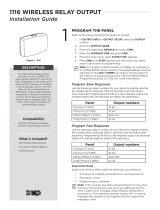 DMP Electronics 1116 Installation guide
DMP Electronics 1116 Installation guide
-
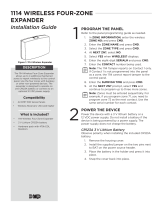 DMP Electronics 1114 Installation guide
DMP Electronics 1114 Installation guide
-
DMP Electronics 1100R Installation guide
-
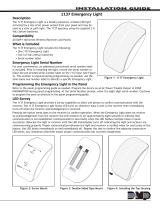 DMP Electronics 1137 User manual
DMP Electronics 1137 User manual
-
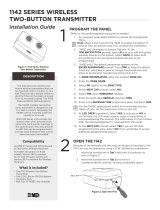 DMP Electronics 1142 Series Installation guide
DMP Electronics 1142 Series Installation guide
-
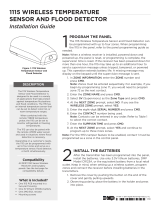 DMP Electronics 1115 Installation guide
DMP Electronics 1115 Installation guide
-
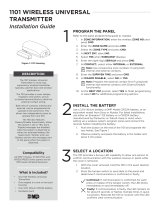 DMP Electronics 1101 Installation guide
DMP Electronics 1101 Installation guide
-
 DMP Electronics 1106 Installation guide
DMP Electronics 1106 Installation guide
-
DMP Electronics 1101 Series Installation guide
Other documents
-
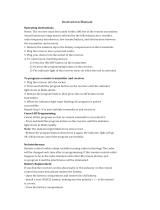 dewenwils 006 User manual
dewenwils 006 User manual
-
dewenwils 009 User manual
-
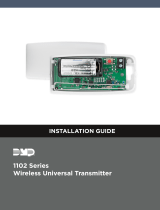 Digital Monitoring Products 1102 Universal Transmitter Installation guide
Digital Monitoring Products 1102 Universal Transmitter Installation guide
-
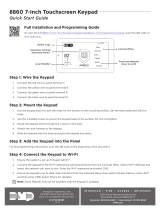 Digital Monitoring Products 8860 Series 7-Inch Touchscreen Keypad Quick start guide
Digital Monitoring Products 8860 Series 7-Inch Touchscreen Keypad Quick start guide
-
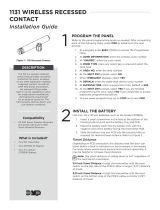 Digital Monitoring Products 1131 Installation guide
Digital Monitoring Products 1131 Installation guide
-
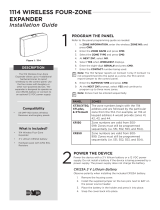 Digital Monitoring Products 1114 Four-Point Wireless Zone Expander Installation guide
Digital Monitoring Products 1114 Four-Point Wireless Zone Expander Installation guide
-
dewenwils HRS101K1 User manual
-
dewenwils HRS205M User manual
-
dewenwils HRS103M User manual
-
DMP 1132 Installation guide















